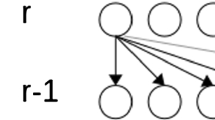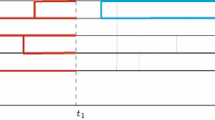Abstract
We study a class of coalescents derived from a sampling procedure out of \(N\) i.i.d. Pareto\(\left( \alpha \right) \) random variables, normalized by their sum, including \(\beta \) –size-biasing on total length effects (\(\beta <\alpha \)). Depending on the range of \(\alpha ,\) we derive the large \(N\) limit coalescents structure, leading either to a discrete-time Poisson-Dirichlet \( \left(\alpha ,-\beta \right) \Xi -\)coalescent (\(\alpha \in \left[ 0,1\right) \)), or to a family of continuous-time Beta\(\left( 2-\alpha ,\alpha -\beta \right) \Lambda -\)coalescents (\(\alpha \in \left[ 1,2\right) \)), or to the Kingman coalescent (\(\alpha \ge 2\)). We indicate that this class of coalescent processes (and their scaling limits) may be viewed as the genealogical processes of some forward in time evolving branching population models including selection effects. In such constant-size population models, the reproduction step, which is based on a fitness-dependent Poisson Point Process with scaling power-law\(\left( \alpha \right) \) intensity, is coupled to a selection step consisting of sorting out the \(N\) fittest individuals issued from the reproduction step.
Similar content being viewed by others
Notes
This particular way of introducing selection in a randomly evolving branching population with constant poulation size seems to appear first in Brunet et al. (2006). It has nothing to do with the way selection is classically introduced in population genetics; see Maruyama (1977), Ewens (2004) and Bürger (2000).
We abusively use the same notation \(P_{i,1}^{\left( N\right) }\) in the size-biased setup as in (1) (corresponding to \(\beta =0\)), to avoid overburden notations.
A ‘true’ coalescent process takes values in the set of equivalence relations or partitions on \(\left\{ 1,\ldots ,N\right\} \) and we rather deal here and throughout with its block-counting counterpart.
Here, because two processes are involved, the symbol \(\overset{d}{=}\) means convergence of all the finite-dimensional distributions of \(x_{\left[ t/c_{N}\right] }^{\left( N\right) }, t\ge 0\) to the ones of \(x_{t}, t\ge 0\).
\(\overset{d}{=}\) means equality in distribution between random variables.
The technique we use is inspired from the one used in Brunet and Derrida (2013) in a particular case. The author is indebted to B. Derrida for pointing this out to him.
The \(^{\prime }\) symbol indicates derivative with respect to \(x\).
We used the scaling property of Pareto\(\left( \alpha \right) \) rvs \(X\) on \( \left( 1,\infty \right) \) stating that \(X\mid X>a\overset{d}{=}aX.\)
References
Bérard J, Gouéré J-B (2010) Brunet-Derrida behavior of branching-selection particle systems on the line. Commun. Math. Phys. 298(2):323–342
Bertoin J (2000) Subordinators. Maphysto, Centre for Mathematical Physics and Stochastics, Department of Mathematical Sciences, University of Aarhus, Lévy processes with no negative jumps and branching processes. Lecture Notes of the concentrated advanced course on Lévy processes
Birkner M, Blath J (2008) Computing likelihoods for coalescents with multiple collisions in the infinitely many sites model. J Math Biol 57(3):435–465
Bouchaud J-P, Georges A (1990) Anomalous diffusion in disordered media: statistical mechanisms, models and physical applications. Phys Rep 195(4–5):127–293
Brunet É, Derrida B, Mueller AH, Munier S (2006) Noisy traveling waves: effect of selection on genealogies. Europhys Lett 76:1
Brunet É, Derrida B, Mueller AH, Munier S (2007) Effect of selection on ancestry: an exactly soluble case and its phenomenological generalization. Phys Rev E 76:041–104
Brunet É, Derrida B (2013) Genealogies in simple models of evolution. J Stat Mech (special issue on Dynamics of Evolution, P01006)
Bürger R (2000) The mathematical theory of selection, recombination, and mutation. Wiley series in mathematical and computational biology. Wiley, Chichester, p xii+409
Caliebe A, Neininger R, Krawczak M, Rösler U (2007) On the length distribution of external branches in coalescence trees: genetic diversity within species. Theoret Popul Biol 72(2):245–252
Dhersin J-S, Freund F, Siri-Jégousse A, Yuan L (2012) On the length of an external branch in the Beta-coalescent. arXiv:1201.3983
Dhersin J-S, Yuan L (2012) Asymptotic behavior of the total length of external branches for Beta-coalescents. arXiv:1202.5859
Drmota M, Iksanov A, Möhle M, Roesler U (2007) Asymptotic results concerning the total branch length of the Bolthausen–Sznitman coalescent. Stoch Process Appl 117(10):1404–1421
Eldon B, Wakeley J (2006) Coalescent processes when the distribution of offspring number among individuals is highly skewed. Genetics 172:2621–2633
Ewens WJ (2004) Mathematical population genetics. I. Theoretical introduction. Interdisciplinary applied mathematics, vol 27, 2nd edn. Springer, New York
Freund F, Möhle M (2009) On the time back to the most recent common ancestor and the external branch length of the Bolthausen-Sznitman coalescent. Markov process. Relat Fields 15(3):387–416
Gnedin A, Iksanov A, Möhle M (2008) On asymptotics of exchangeable coalescents with multiple collisions. J Appl Probab 45(4):1186–1195
Goldschmidt C, Martin JB (2005) Random recursive trees and the Bolthausen–Sznitman coalescent. Electron J Probab 10(21):718–745
Huillet T (2003) Energy cascades as branching processes with emphasis on Neveu’s approach to Derrida’s random energy model. Adv Appl Probab 35(2):477–503
Huillet T, Möhle M (2013) On the extended Moran model and its relation to coalescents with multiple collisions. Theor Popul Biol (online first papers). doi: 10.1016/j.tpb.2011.09.004
Huillet T, Möhle M (2012) Asymptotics of symmetric compound Poisson population models. Available at hal-00730734 (preprint)
Iksanov A, Möhle M (2007) A probabilistic proof of a weak limit law for the number of cuts needed to isolate the root of a random recursive tree. Electron Comm Probab 12:28–35
Janson S, Kersting G (2011) On the total external length of the Kingman coalescent. Electron J Probab 16(80):2203–2218
Karlin S, McGregor J (1964) Direct product branching processes and related Markov chains. Proc Nat Acad Sci USA 51:598–602
Kersting G (2011) The asymptotic distribution of the length of Beta-coalescent trees. arXiv:1107.2855v2
Kingman JFC (1993) Poisson processes. Oxford studies in probability, vol 3. Oxford Science Publications, The Clarendon Press, Oxford University Press, New York
Kingman JFC (1982) The coalescent. Stoch Process Appl 13:235–248
Lamperti JW (1967) Continuous state branching processes. Bull Am Math Soc 73:382–386
Maruyama T (1977) Stochastic problems in population genetics. Lecture notes in biomathematics, vol 17. Springer, Berlin-New York
Möhle M (2006) On the number of segregating sites for populations with large family sizes. Adv Appl Probab 38(3):750–767
Möhle M, Sagitov S (2001) A classification of coalescent processes for haploid exchangeable population models. Ann Probab 29(4):1547–1562
Möhle M (2010) Asymptotic results for coalescent processes without proper frequencies and applications to the two-parameter Poisson-Dirichlet coalescent. Stoch Process Appl 120(11):2159–2173
Neveu J (1992) A continuous state branching process in relation with the GREM model of spin glass theory. Unpublished technical report 267, École Polytechnique, France
Perman M (1993) Order statistics for jumps of normalized subordinators. Stoch Process Appl 46:267–281
Pitman J (1999) Coalescents with multiple collisions. Ann Probab 27(4):1870–1902
Pitman J, Yor M (1997) The two parameter Poisson-Dirichlet distribution derived from a stable subordinator. Ann Probab 25:855–900
Sagitov S (1999) The general coalescent with asynchronous mergers of ancestral lines. J Appl Probab 36(4):1116–1125
Schweinsberg J (2000) Coalescents with simultaneous multiple collisions. Electron J Probab 5:1–50 (Paper no. 12)
Schweinsberg J (2000) A necessary and sufficient condition for the \(\Lambda \)-coalescent to come down from infinity. Electron Comm Probab 5:1–11
Schweinsberg J (2003) Coalescent processes obtained from supercritical Galton-Watson processes. Stoch Process Appl 106(1):107–139
Tavaré S (2004) Ancestral inference in population genetics. Lectures on probability theory and statistics, Saint-Flour 2001, Lecture notes in mathematics, 1837, Springer, Berlin, pp 1–188
Uchaikin VV, Zolotarev VM (1999) Chance and stability. Stable distributions and their applications. With a foreword by V. Yu. Korolev and Zolotarev. Modern probability and statistics. VSP, Utrecht
Zaliapin IV, Kagan YY, Schoenberg F (2005) Approximating the distribution of Pareto sums. Pure Appl Geoph 162(6–7):1187–1228
Acknowledgments
The author acknowledges partial support from the ANR Modélisation Aléatoire en Écologie, Génétique et Évolution (ANR-Manège- 09-BLAN-0215 project) and from the labex MME-DII (Modèles Mathématiques et Économiques de la Dynamique, de l’ Incertitude et des Interactions). The author is also indebted to his referees for pointing out some errors in an earlier version of the draft and for encouraging him to write down a more concise and complete version.
Author information
Authors and Affiliations
Corresponding author
Rights and permissions
About this article
Cite this article
Huillet, T.E. Pareto genealogies arising from a Poisson branching evolution model with selection. J. Math. Biol. 68, 727–761 (2014). https://doi.org/10.1007/s00285-013-0649-7
Received:
Revised:
Published:
Issue Date:
DOI: https://doi.org/10.1007/s00285-013-0649-7
Keywords
- Pareto coalescents
- Scaling limits
- Poisson-Dirichlet
- Kingman and Beta coalescents
- Poisson point process
- Evolution model including selection




